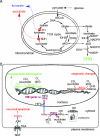Inborn and acquired metabolic defects in cancer
- PMID: 21301796
- PMCID: PMC3043233
- DOI: 10.1007/s00109-011-0728-4
Inborn and acquired metabolic defects in cancer
Abstract
The observation that altered metabolism is the fundamental cause of cancer was made by Otto Warburg nearly a century ago. However, the subsequent identification of oncogenes and tumor suppressor genes has displaced Warburg's theory pointing towards genetic aberrations as the underlining cause of cancer. Nevertheless, in the last decade, cancer-associated mutations have been identified in genes coding for tricarboxylic acid cycle (TCA cycle, also known as Krebs cycle) and closely related enzymes that have essential roles in cellular metabolism. These observations have revived interest in Warburg's hypothesis and prompted a flurry of functional studies in the hope of gaining mechanistic insight into the links between mitochondrial dysfunction, metabolic alterations, and cancer. In this review, we discuss the potential pro-oncogenic signaling role of some TCA cycle metabolites and their derivatives (oncometabolites). In particular, we focus on their effects on dioxygenases, a family of oxygen and α-ketoglutarate-dependent enzymes that control, among other things, the levels and activity of the hypoxia-inducible transcription factors and the activity of DNA and histone demethylases.
Figures

References
Publication types
MeSH terms
Substances
LinkOut - more resources
Full Text Sources

